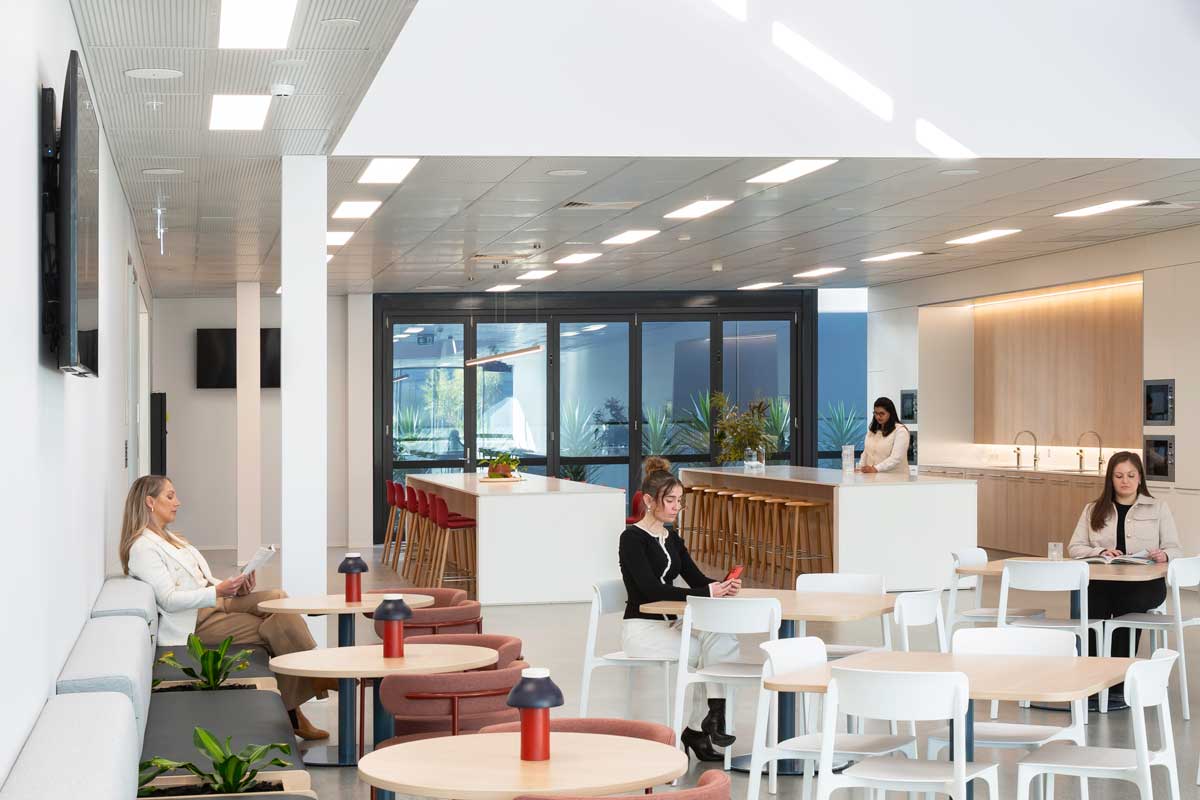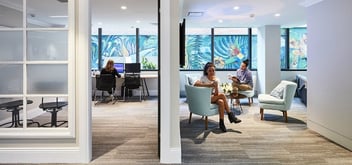
Commercial Office Fitouts & Design in Australia | Axiom Workplaces

At Axiom, we deliver end-to-end commercial office fitout solutions in Aus tailored to modern business needs. Our focus is on thoughtful design that enhances productivity, utilises space efficiently, and reflects your brand identity. Whether you're creating a new workspace or upgrading an existing one, we ensure every fitout is functional, stylish, and built with quality. Our team combines ergonomic planning with smart layouts to support employee comfort and wellbeing throughout the day. From concept to completion, we handle everything ensuring your commercial space not only looks good but also performs exceptionally. With a commitment to excellence, we make every project a success through attention to detail and a personalised approach.
Understanding the Importance of a Well-Designed Office Space
A well-designed office space is crucial for the success of any business. It plays a significant role in creating a positive work environment and enhancing productivity. A well-designed office space can improve employee satisfaction, engagement, and overall well-being. It can also leave a lasting impression on clients and visitors, reflecting the professionalism and success of the company.
At Axiom, we deliver end-to-end commercial office fitout solutions tailored to modern business needs. Our focus is on thoughtful design that enhances productivity, utilises space efficiently, and reflects your brand identity. Whether you're creating a new workspace or upgrading an existing one, we ensure every fitout is functional, stylish, and built with quality. Our team combines ergonomic planning with smart layouts to support employee comfort and wellbeing throughout the day. From concept to completion, we handle everything, ensuring your commercial space not only looks good but also performs exceptionally. With a commitment to excellence, we make every project a success through attention to detail and a personalised approach.
When designing a commercial office fitout, it is important to consider the layout, functionality, and aesthetics of the space. A well-designed office space should promote collaboration, communication, and creativity among employees. It should provide them with the necessary tools, resources, and comfort to perform their tasks efficiently.
Additionally, a well-designed office space can have a positive impact on employee morale and motivation. It can create a sense of belonging and pride in the company, leading to increased loyalty and productivity. A well-designed office space can also attract top talent and help retain existing employees, as it is often seen as a reflection of the company's culture and values.
Determining the Needs and Goals of Your Commercial Office Fitout

Before embarking on a commercial office fitout, it is essential to determine the needs and goals of your business. This involves understanding the specific requirements of your employees, the nature of your work, and the overall objectives of your company.
Start by conducting a thorough assessment of your current office space. Identify any pain points, inefficiencies, or areas that need improvement. Consider factors such as the number of employees, departments, and the type of work being done. Determine if there is a need for more meeting rooms, collaboration areas, or private offices.
Next, define the goals you want to achieve with your office fitout. Are you aiming to improve employee productivity, enhance collaboration, or create a more flexible and adaptable workspace? Understanding your goals will help guide the design and layout of your office fitout.
Finally, involve your employees in the decision-making process. Seek their input and feedback to ensure that their needs and preferences are taken into account. This will not only result in a more successful office fitout but also foster a sense of ownership and engagement among your employees. Consider using a workplace strategist to gather the information you need using a defined and process such as the wrkx TM INDEX. The information you discover can help guide decisions and save time and money later.
How to Choose the Right Layout and Furniture

The layout and furniture of your office space play a crucial role in creating a functional and productive work environment. When choosing the layout, consider the flow of traffic, accessibility, and the specific needs of different departments.
Open-plan layouts are popular for promoting collaboration and communication among employees. They allow for easy interaction and can create a sense of unity and teamwork. However, it is important to also provide designated quiet areas or private spaces for tasks that require concentration and privacy.
When selecting furniture, prioritize comfort, flexibility, and ergonomics. Ensure that chairs, desks, and workstations are adjustable and provide adequate support for long hours of sitting. Consider investing in standing desks or ergonomic accessories to promote a healthy and comfortable work environment.
Remember to also consider the aesthetic appeal of the furniture. Choose pieces that reflect your company's brand and values. Incorporate colors, materials, and textures that create a cohesive and visually appealing office space.
View case studies on office fitouts
Maximizing Productivity through Optimising Lighting, Acoustics, and Ergonomics
Proper lighting, acoustics, and ergonomics are essential elements of a well-designed office space. They can significantly impact employee comfort, productivity, and well-being.
Optimize lighting by maximizing natural light and supplementing it with artificial lighting that mimics natural daylight. Natural light has been proven to boost mood, energy levels, and overall well-being. Ensure that workstations have proper task lighting to minimize eye strain and fatigue.
Acoustics also play a vital role in creating a conducive work environment. Minimize noise distractions by incorporating sound-absorbing materials, such as carpets, acoustic wall panels, and ceiling tiles. Consider providing quiet zones or noise-canceling headphones for employees who require a quieter workspace.
Ergonomics is crucial for preventing musculoskeletal disorders and promoting employee health and comfort. Provide adjustable chairs, desks, and monitor stands to accommodate different body types and preferences. Encourage employees to take regular breaks, stretch, and maintain good posture to prevent injuries and fatigue.

Incorporating Branding and Aesthetics into Your Office Fitout
Incorporating branding and aesthetics into your office fitout is a great way to create a unique and inspiring workspace that reflects your company's identity and values.
Start by incorporating your company's logo, colors, and visual elements into the office design. Use these elements consistently throughout the space to create a cohesive and recognizable brand presence. Consider using signage, wall graphics, or custom artwork to showcase your brand story and values.
Additionally, pay attention to the overall aesthetics of the office space. Choose furniture, finishes, and accessories that align with your company's style and create a visually appealing environment. Consider incorporating elements of nature, such as plants or green walls, to bring life and freshness into the space.
Remember, a well-designed office space that incorporates branding and aesthetics can leave a lasting impression on clients, visitors, and employees. It can create a sense of pride and belonging among your team, fostering a positive and inspiring work culture.
Choosing the Right Commercial Office Fitout and Design for Your Business

Investing in a commercial office fitout and design is more than just updating furniture or giving your workspace a facelift; it's about aligning your environment with how your business operates today and into the future. A well-planned commercial office fit out can increase productivity, support employee wellbeing, and enhance your company's image.
Whether you’re relocating, expanding, or rethinking your current space, a smartly executed commercial fit out office can transform your day-to-day operations. Our team at Axiom Workplaces understands that every business has different needs, which is why we tailor workspace fitouts to suit your specific goals, workflows, and brand.
Ergonomics and Employee Wellbeing
A key part of our approach is designing ergonomic office fit outs that promote comfort and efficiency. From adjustable workstations to seating that supports good posture, the right ergonomics are essential to reducing fatigue and improving long-term health. Including these principles in your commercial office fitout design means your team will be better equipped to perform at their best every day.
Functional and Stylish Furniture
Choosing the right commercial office fitout furniture goes beyond looks. It’s about selecting durable, flexible pieces that suit how your teams work. Whether it's collaborative zones, quiet focus areas, or multifunctional meeting rooms, we help you choose office furniture that works just as hard as your people do.
Customized Commercial Fitout Solutions
No two offices are the same. That’s why we take a personalized approach to every commercial fitout project. We assess your space, listen to your team’s needs, and create solutions that maximise every square metre. Whether you’re designing a new build or updating an older workspace, a well-executed commercial office fitout makes a powerful difference in both performance and perception.
Office Make Good and End-of-Lease Services
When a lease ends, businesses are often required to return their space to its original condition. This is where commercial offices make good services come in. Axiom can help manage this process efficiently ensuring you meet your obligations while preparing for your next office transformation.
Why Choose Axiom for Your Office Fit Out
Choosing the right partner for your office fit out can make all the difference. At Axiom, we take the stress out of the process by offering a complete, end-to-end service from strategy and design to construction and delivery. Our team has extensive experience delivering high-performing commercial office fit outs that are tailored to the way modern businesses operate.
What sets us apart is our ability to combine functional planning with strong visual appeal. We understand how important it is for your space to reflect your brand, support your team, and adapt as your business grows. Every project we deliver is carefully planned and backed by years of industry insight.
We don’t believe in one-size-fits-all solutions. Instead, we take time to understand your goals and translate them into workspace fitouts that feel right and work well. Whether you need to create more room, improve flow, or simply upgrade the look and feel of your office, our approach is always thoughtful and people-focused.
When you work with Axiom, you’re not just getting a design, you're getting a partner who is invested in your success.
To see how we’ve helped other businesses transform their offices, explore our latest commercial office fitouts.
Conclusion – Designing for the Future of Work

A well-planned commercial office fitout is more than a design upgrade; it's a strategic step that can reshape how your business operates, communicates, and grows. The right environment supports your team, reflects your values, and gives your company a solid foundation for the future.
As work habits evolve, your commercial workplace must adapt too. Whether you're planning a move, a redesign, or a full transformation, investing in a smart, practical, and beautiful office fit out can drive long-term results. But with so many moving parts involved, it’s important to have an experienced team guiding you.
At Axiom, we’re here to help you create a space that performs as well as it looks. From early workplace strategy to final handover, we handle every stage with care, creativity, and a focus on what matters most to you.
If you’re ready to reimagine your workplace, let’s start a conversation.





